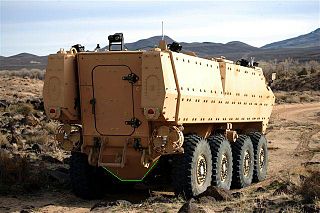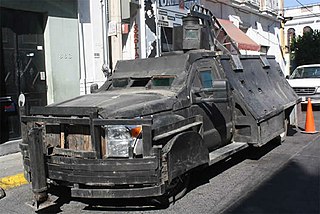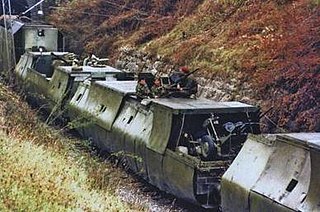Related Research Articles

Panzerschreck was the popular name for the Raketenpanzerbüchse 54, an 88 mm reusable anti-tank rocket launcher developed by Nazi Germany in World War II. Another earlier, official name was Ofenrohr.

A club is a short staff or stick, usually made of wood, wielded as a weapon since prehistory. There are several examples of blunt-force trauma caused by clubs in the past, including at the site of Nataruk in Turkana, Kenya, described as the scene of a prehistoric conflict between bands of hunter-gatherers 10,000 years ago.

An armoured train is a railway train protected with heavy metal plating and which often includes railway wagons armed with artillery, machine guns and autocannons. Some also had slits used to fire small arms from the inside of the train, especially in earlier armoured trains. For the most part they were used during the late 19th and early 20th centuries, when they offered an innovative way to quickly move large amounts of firepower into a new location. Most countries discontinued their use – road vehicles became much more powerful and offered more flexibility, train tracks proved too vulnerable to sabotage and attacks from the air, and air transportation was an even more flexible to relocate firepower to a new location. However, there were occasional uses in the late 20th centuryand early 21st century Russian Federation used improvised armoured trains in the Second Chechen War of 1999–2009 and the Russian invasion of Ukraine in 2022.

The Israeli Combat Engineering Corps is the combat engineering forces of the Israel Defense Forces.
The School of Infantry (SOI) is the second stage of initial military training for enlisted United States Marines after recruit training. Since the initial training pipeline is divided between coasts, Marines from areas east of the Mississippi River usually graduate from MCRD Parris Island and move on to SOI at SOI East, while those from the western half of the nation attend MCRD San Diego and move on to SOI West at the Camp San Onofre area of Camp Pendleton in California. Female Marines are trained at both SOI East and SOI West. The School of Infantry's training mission ensures "Every Marine is, first and foremost, a Rifleman". At SOI, Marines with the Military Occupational Specialty of infantry are trained at the Infantry Training Battalion (ITB), while all non-infantry Marines are trained in basic infantry and combat skills at the Marine Combat Training Battalion. SOI marks a transition in the professional training of entry-level students from basically trained Marines to combat-ready Marines.

A gun truck is an armored vehicle with one or more crew-served weapons, typically based on a commercial vehicle. Gun trucks often have improvised vehicle armor, such as scrap metal, concrete, gravel, or sandbags, which is added to a heavy truck.
The Kabutowari, also known as hachiwari, was a type of knife-shaped weapon, resembling a jitte in many respects. This weapon was carried as a side-arm by the samurai class of feudal Japan.

The Bob Semple tank was a light tank designed by New Zealand Minister of Works Bob Semple during World War II. Originating out of the need to build military hardware from available materials, the tank was built from corrugated iron on a tractor base. Designed and built during a period of uncertainty in which New Zealand feared having to defend itself from Japanese invasion without external assistance, these tanks were a civilian effort to design and create a means to protect New Zealand.

The United States Army Armor School is a training school located at Fort Benning, Georgia. Its primary focus is the training of United States Army soldiers, non-commissioned officers, warrant officers, and commissioned officers. It also trains for equipment handling, including the M1 Abrams, the Bradley Fighting Vehicle, and the Stryker Mobile Gun System. The Armor School moved to Fort Benning in 2010 as part of the United States Base Realignment and Closure program.

The V-hull is a type of vehicle armor design used on wheeled armored personnel carriers (APCs), infantry mobility vehicles, infantry fighting vehicles (IFVs) and MRAPs. The design originated in the 1970s with vehicles such as the iconic Casspir used extensively during the South African Border War, Leopard security vehicle used in the Rhodesian Bush War and South African armored vehicle company Land Systems OMCs and Buffels.

The Type 96 Wheeled Armored Personnel Carrier is an armoured vehicle that entered service with Japan in 1996. This vehicle complements the existing fleet of tracked Type 73 Armored Personnel Carriers already in service.

The AMZ Żubr is an infantry mobility vehicle produced by AMZ-Kutno which is used by the Polish military. "Żubr" is also the Polish word for wisent. It was designed by AMZ-Kutno and began production in 2008. The standard Żubr variant, the Żubr MRAP, is based on the Iveco EuroCargo vehicle, which is produced in Poland.
An anti-tank grenade is a specialized hand-thrown grenade used to defeat armored targets. Although their inherently short range limits the usefulness of grenades, troops can lie in ambush or maneuver under cover to exploit the limited outward visibility of the crew in a target vehicle. Hand launched anti-tank grenades became redundant with the introduction of standoff rocket propelled grenades.
Armored trains of Poland mostly date to the World War I period. Many of them were modernized over the next two decades, and took part in most military conflicts of the Second Polish Republic, namely the Greater Poland Uprising, the Polish-Ukrainian War, the Polish-Bolshevik War, the Silesian Uprisings and the Polish September Campaign in World War II. Armored trains were also used by the Polish Armed Forces in the West as well as in the post-war period by the Polish Railroad Guards and the People's Army of Poland.

A narco tank, also called rhino trucks or monstruos, is a type of improvised fighting vehicle used by drug cartels. The vehicles are primarily civilian trucks with improvised vehicle armour, which adds operational mobility, tactical offensive, and defensive capabilities when fighting law enforcement or rivals during drug trafficking activities.

The Krajina Express was an improvised armored train used by the Krajina Serb army during the Croatian War of Independence and the Bosnian War, from 1991 to 1995.
The VP22 is a family of armored, MRAP transport and patrol all-terrain vehicles, manufactured by China North Industries Corporation (Norinco). It is the 6x6 derivation of the BeiBen Truck Kaijia 8x8 MRAP vehicle. The intended role for VP22 is to operate in high threat areas that requires mine protection capability. It can transport troops and cargo in the armored cabin. The VP22 has a modular design. Several mission modules can be fitted onto the chassis, including troop transport, command post, and armored ambulance.
METİ, in capitalized form short for, literally land mine and improvised explosive device detection and disposal vehicle, is a wheeled armored explosive ordnance disposal (EOD) vehicle. It was developed in Turkey and manufactured by the BMC Turkey. Introduced in 2021, it is in use by the Turkish Army.